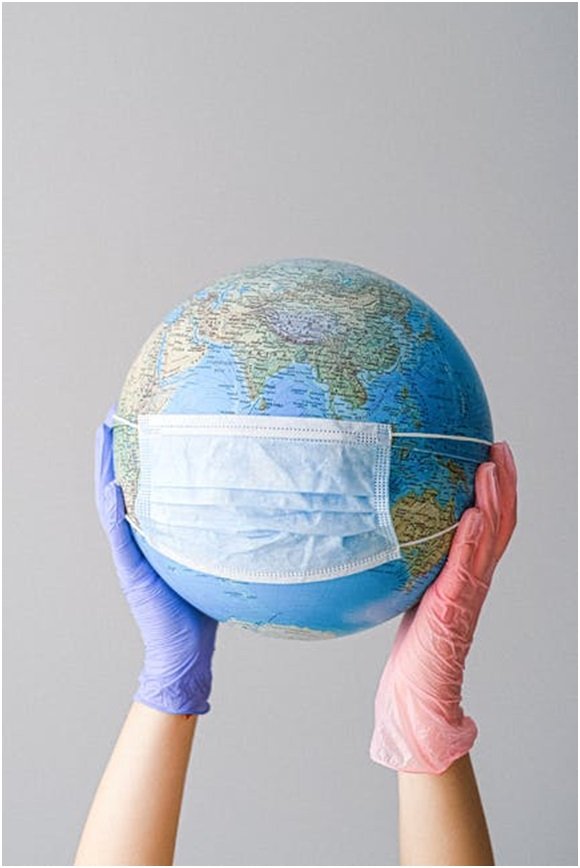Now that the COVID-19 pandemic has us masking up and staying indoors, virus prevention has gone from a vague recommendation to an absolute necessity.
But how does the coronavirus spread, anyway? Do you need to sanitize everything you touch? And what do masks do?
Well, viruses like the coronavirus can be transmitted through a variety of pathways. An unsuspecting person might pick up the pathogen from a contaminated doorknob, a handshake, or a sneeze. This might make it seem like the whole world is a soup of infectious material, but we’ll help you separate fear from fact.

When you take certain basic precautions to protect yourself from these forms of transmission, you’ll go from asking, “How are viruses spread?” to understanding your role in preventing the spread. Let us walk you through how to avoid coronavirus and any other virus that might threaten your health.
Surfaces
Viruses aren’t technically alive. This is because they can’t reproduce on their own outside of the human body. Once a virus lands on a surface (after, say, someone sneezes near a table), that virus will only last so long before it starts to degrade.
Still, if you pick up the virus before it’s degraded beyond infectious potential, this could be the germ’s way to your body.
How Long Do Viruses “Live” on Surfaces?
The good news is that viruses don’t last forever outside the body. Once they’re on a surface, they have a limited amount of time before they die and are no longer infectious.
The not-so-great news is that this lifespan might be longer than you think. Depending on the surface, enveloped viruses like the flu can survive anywhere from a few hours to days.
But don’t panic just yet! According to Dr. Anthony Fauci of the National Institute of Allergy and Infectious Disease, points out that these “survival time” measures are tested in isolated lab conditions, where viruses are allowed to grow as long as possible. In the real world, viruses can be threatened by things like temperature changes.
So it might be a good idea to disinfect surfaces that have come into a lot of contact, like doorknobs. But there’s no need to go overboard. After a day or so, you won’t have to worry so much about the threat of infection.
How to Disinfect Surfaces
Disinfecting surfaces is an excellent part of maintaining a healthy home or business, whether there’s a pandemic going on or not. But if you haven’t looked up the best way to clean, you might be missing some important steps.
For example, did you know that disinfectants have a “wait time” for full effectiveness? Take a look at the disinfectant bottle you’re using to see what the specifications are. The process goes like this: spray, wait, then wipe.
If you’re worried about a harsh disinfectant damaging your surface, you can do a gentle rinse. Make sure to wait long enough for the product to be effective, and then you can wipe the surface with a moist cloth or paper towel.
Using Gloves
Gloves can be an effective barrier between you and contaminated surfaces, as long as you use them correctly.
When you take your gloves off, make sure to turn them inside out. You can do this by reaching under the wrist opening and peeling the glove off from there. This ensures that you never have to touch the outside of the gloves.
Contact
Viruses can also spread from person to person through actual contact. For example, you might shake someone’s hand, then scratch your nose. This is one way the virus can get into your body.
You can reduce the risk of virus transmission by washing your hands frequently. And when you’re particularly concerned about a virus, like the coronavirus, you can eliminate contact risk by refusing handshakes and other contact until the threat of widespread infection is over.
Droplet Transmission
Another way viruses can spread is through tiny droplets of fluid that travel through the air. Note that this is different from airborne transmission. While certain barriers can protect against a spray of droplets, airborne transmission is harder to protect against.
When it comes to the coronavirus, one of the biggest public health concerns is droplet transmission. Experts disagree over whether airborne coronavirus spread is a significant threat or not. In the meantime, we can do our best to protect ourselves from any kind of transmission that travels through the air.
How are Viruses Spread Through Sneezes and Coughs?
When someone sneezes or coughs, small droplets of saliva or nasal fluid travel at high speeds and long distances through the air. This is why experts recommend a distance of six feet apart from other people during the COVID-19 pandemic.
If you don’t maintain this distance, you put yourself at risk for breathing in these droplets. This is how you might get infected with the coronavirus or any other virus.
The Effectiveness of Masks
Using a face mask is an excellent way to prevent droplet transmission of viruses. It protects both you and the people around you, but it protects other people more.
If someone sneezes around you and you’re wearing a mask, you still carry some risk of breathing in the droplets. But if you sneeze and you’re wearing a mask, the droplets are more effectively contained. For this reason, you should try to urge the people around you to wear a mask so that everyone stays safe from each other’s droplets.
Stay Safe Out (Or In) There!
Whether you’re staying indoors, cautiously making your way back to the workplace, or continuing your role as an essential worker, you have the power to significantly reduce your risk of catching the coronavirus. Wear a mask, wear gloves when you can, and avoid contact with other people.
So, how are viruses spread? Well, aside from all the ways we’ve outlined in this post, viruses are spread when people don’t take the proper precautions to prevent this from happening.
Be proactive and do what you can to stop the spread! And if you want to learn more about health and your role in protecting it, check out the rest of our site!




